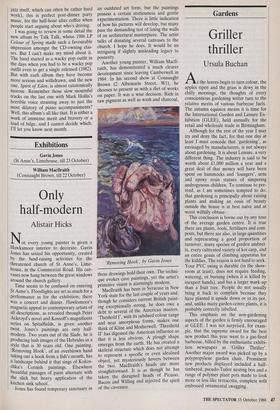Exhibitions
Gavin Jones (St Anne's, Limehouse, till 23 October)
Only half-modern
Alistair Hicks
Not every young painter is given a Hawksmoor interior to decorate. Gavin Jones has seized his opportunity, created by the fund-raising activities for the threatened church of St Anne's, Lime- house, in the Commercial Road. His can- vases now hang between the great windows around the church gallery.
Time seems to be confused on entering St Anne's. Floodlights are set as much for a performance as for the exhibition; there was a concert and dinner. Hawksmoor's magnetic appeal to contemporary artists of all descriptions, as revealed through Peter Ackroyd's novel and Kossoff's magnificent series on Spitalfields, is given another twist. Jones's paintings are only half- modern. Two years out of the Slade, he is producing lush images of the Hebrides in a style that is 30 years old. One painting, 'Removing Hook', of an overblown hand taking out a hook from a fish's mouth, has a landscape behind it that sings of Kokos- chka's Cornish paintings. Elsewhere beautiful passages of paint alternate with the slick but heavy application of the kitchen sink school.
Jones has found temporary sanctuary in
an outdated art form, but the paintings possess a certain restlessness and gentle experimentation. There is little indication of how his pictures will develop, but many pass the demanding test of lining the walls of an architectural masterpiece. The artist talks of donating several canvases to the church. I hope he does. It would be an intriguing if slightly misleading legacy to posterity. Another young painter, William MacIl- raith, has demonstrated a much clearer development since leaving Camberwell in 1984. In his second show at Connaught Brown (2 Albemarle Street, WI), he chooses to present us with a diet of works on paper. It was a wise decision. Rich in raw pigment as well as wash and charcoal, 'Removing Hook', by Gavin Jones these drawings hold their own. The techni- que evokes cave paintings, yet the artist's primitive vision is alarmingly modern. Macllraith has been in Syracuse in New York state for the last couple of years and, though he considers current British paint- ing exceptionally strong, he does owe a debt to several of the American masters. `Theshold I', with its subdued colour range and near amorphous forms, makes one think of Kline and Motherwell. 'Threshold II' has digested the American influence so that it is less obvious. A plough shape emerges from the earth. He has created a skeletal structure which does not attempt to represent a specific or even idealised object, yet mysteriously hovers between the two. MacIlraith's heads are more straightforward. It is as though he has taken the disrupted heads of Picasso, Bacon and Willing and injected the spirit of the cavemen.


























































 Previous page
Previous page